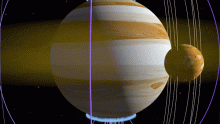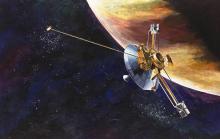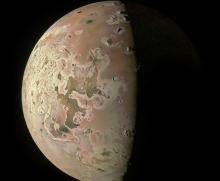Listen to today's episode of StarDate on the web the same day it airs in high-quality streaming audio without any extra ads or announcements. Choose a $8 one-month pass, or listen every day for a year for just $30.
You are here
Moon and Planets
The Moon and three bright planets form a beautiful lineup the next few mornings. The planets align to the lower left of the Moon tomorrow, but the Moon will snuggle closer to them the following couple of days.
Two of the planets form a tight pair — Mars and Jupiter. They’re to the lower left of the Moon tomorrow. Jupiter is the brighter of the two. It’s the brightest object in the night sky after the Moon and Venus, so you can’t miss it. Mars is a good bit fainter right now, but it’s headed toward a brilliant showing later in the year.
That’s because Mars will pass closest to Earth in October. Its distance from us varies by a factor of about seven. In other words, when it’s farthest from Earth, it’s seven times farther than when it's closest.
As a result, Mars’s brightness varies by quite a bit. At its peak, it can outshine Jupiter. At its faintest, though, it’s a much more modest target. Right now, it’s toward the lower end of that range.
Jupiter stays much farther from us, so it experiences a smaller range in brightness. It never ranks lower than the fourth-brightest object in the night sky.
The final planet in the morning lineup is Saturn, to the lower left of Mars and Jupiter. It’s even farther than Jupiter is, so its brightness range is smaller. Even at its faintest, though, it’s among the 25 brightest objects in the night sky — a bright target all year long.
More about this morning lineup tomorrow.
Script by Damond Benningfield





